All cars need maintenance. The fact is mechanical devices wear and fail in normal use, and deteriorate over time, so being able to diagnose a future failure has become a part of the automotive repair and service industry. Customers always ask how long it will be before a component will fail, and are usually not satisfied with the standard, “we can’t predict the future,” answer. We do have tools now to help with at least knowing when a component is showing signs of deterioration. Things like brake wear indicators, on-board diagnostics and numerous sensing components make “guesstimating” possible, but not totally accurate unless previous history is available for comparison. Specializing in specific brands or models helps create a reasonable expectation for the service life of some components. The main variable is, of course, the “nut” behind the wheel.
For emissions and engine management systems, the advent of On-Board Diagnostics (OBD) has been both a curse and a blessing for the technician. While not always foolproof, being able to access on-board data can at least give us a starting point for particular problems. On BMWs, OBD is integrated into almost every model and system, and has been since the late 1980s. Long before OBD II came along in 1995, BMW was generous in accessibility of not only the on-board data, but with the information to make repairs based on that data.
Having access to real-time data gives us a heads-up in predicting or locating a failure, even an intermittent one. We continue to see newer models that have recently come out of lease, or have been traded in, that were “serviced” under the manufacturer-covered schedule. Having always been a proponent of preventive maintenance, I see the result of neglect every day. The main effect is additional repairs for subsequent owners, but also more service and repair work for technicians who take seriously their job of encouraging and informing car owners to maintain their vehicles rather than just repair them.
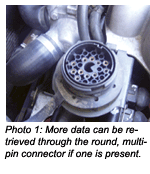 UNDERHOOD
UNDERHOOD
While OBD II-equipped cars are accessible through the standard DLC, if a BMW has the round, multi-pin connector (See Photo 1) under the hood, more data can be accessed there with the proper scanner and software. When the round connector was discontinued on most models after 2001, additional lines of data were made accessible through the OBD II DLC. We’ve found, however, that even with several scanners from several manufacturers, on some individual cars we can access only basic OBD information. An important scanner feature is the ability to perform special functions like activations and service reminder resets, along with compatibility with the underhood connector.
Misfire codes are pretty common, often combined with a tow-in, “cranks but no-start” problem. Under questioning, the customer will usually admit that the service engine soon or check engine light has been on for a while. After pulling misfire codes (P0300, 301, etc.), probably the first step is to pull the engine covers as necessary to remove a spark plug.
Depending on model and engine series, this can take some time, or be relatively simple. All models have had coil-on-plug (COP) ignition since 1992, except the 4-cylinder models. If codes are present, especially individual cylinder misfire codes, then the indicated plug would be the one to pull first.
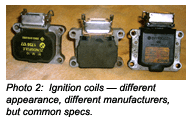 BMW has changed the configuration and application of spark plugs on several models over the last 15 years, recom-mending a switch to platinum-tipped, multi-electrode plugs for longer life. There is a TSB that lists the appropriate replacement recommendations. The manufacturer hasn’t really indicated a replacement interval, however, so we see a lot of these cars with more than 100,000 miles still operating on the original, rather than the updated, plugs. As is the case with any vehicle, sticking with the manufacturer-specified replacement for ignition parts is the best way to avoid compounding a problem by adding another variable.
BMW has changed the configuration and application of spark plugs on several models over the last 15 years, recom-mending a switch to platinum-tipped, multi-electrode plugs for longer life. There is a TSB that lists the appropriate replacement recommendations. The manufacturer hasn’t really indicated a replacement interval, however, so we see a lot of these cars with more than 100,000 miles still operating on the original, rather than the updated, plugs. As is the case with any vehicle, sticking with the manufacturer-specified replacement for ignition parts is the best way to avoid compounding a problem by adding another variable.
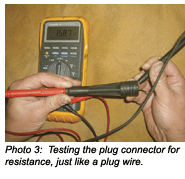 The ignition coils on BMWs have been supplied by a number of different manufacturers (See Photo 2), probably based on supply considerations for assembly plants around the world. Because of the various manufacturers and different outward appearance, you may see cars with mismatched coils. In the real world, some customers won’t buy a full set of replacements when just one fails. There have been a number of service bulletins indicating that this is a bad thing, but I personally don’t know that I’ve had a particular problem with cars that have mismatched sets.
The ignition coils on BMWs have been supplied by a number of different manufacturers (See Photo 2), probably based on supply considerations for assembly plants around the world. Because of the various manufacturers and different outward appearance, you may see cars with mismatched coils. In the real world, some customers won’t buy a full set of replacements when just one fails. There have been a number of service bulletins indicating that this is a bad thing, but I personally don’t know that I’ve had a particular problem with cars that have mismatched sets.
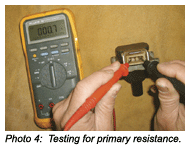 The design of the coil on some models includes a “plug wire” of sorts. The plug connector is actually a resistor wire between the coil and spark plug. The wire can fail for a number of different reasons, most often from oil or water getting into the plug well. Before replacing a coil, performing a couple of simple tests for resistance (See Photos 3 and 4) and power can pinpoint the problem to the coil, wire or lack of computer control to that circuit. An inductive spark tester (See Photo 5) can also be used to check spark production, but may be accurate only with a “dead” coil.
The design of the coil on some models includes a “plug wire” of sorts. The plug connector is actually a resistor wire between the coil and spark plug. The wire can fail for a number of different reasons, most often from oil or water getting into the plug well. Before replacing a coil, performing a couple of simple tests for resistance (See Photos 3 and 4) and power can pinpoint the problem to the coil, wire or lack of computer control to that circuit. An inductive spark tester (See Photo 5) can also be used to check spark production, but may be accurate only with a “dead” coil.
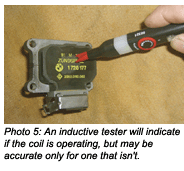 I make it a habit when doing normal service on these cars to change the position of the coils, after marking the original location on the coil. This can be a diagnostic help on cars that may have an intermittent misfire code or driveability problem. Switching locations can also be a diagnostic tool if all of the standard tests fail to pinpoint a cause of a misfire code. Swapping out two coils, clearly marked, then clearing codes and driving until the code comes back, preferably moving with the coil, can pinpoint an otherwise elusive coil problem.
I make it a habit when doing normal service on these cars to change the position of the coils, after marking the original location on the coil. This can be a diagnostic help on cars that may have an intermittent misfire code or driveability problem. Switching locations can also be a diagnostic tool if all of the standard tests fail to pinpoint a cause of a misfire code. Swapping out two coils, clearly marked, then clearing codes and driving until the code comes back, preferably moving with the coil, can pinpoint an otherwise elusive coil problem.
We still get people who want to have a compression test for diagnostic purposes, or during a prepurchase inspection. With OBD II cars, I feel that this is an antiquated practice that gives useless information, and if not performed properly, can cause other problems. If you’re going to perform a compression test and want accurate results, you need to disarm the ignition and fuel system circuits. This is especially important when checking just one cylinder for compression loss, as this will prevent the possibility of filling the other cylinders with gasoline, or, worse yet, causing a fire. You may also need to erase numerous codes from cranking without some components connected. With OBD-equipped cars, if there is a compression problem, there will be a misfire code, and checking the compression would probably be necessary only if no other faults are found.
COOLING SYSTEM
Cooling system problems are a daily diagnostic task at our shop. The cooling systems on the models we generally service, 3 and 5 Series cars and SUVs, all have similar components and operation. The same problems occur with all of the various engine and chassis configurations. I’ve covered water pump problems in previous articles, so I’ll add a few others here.
Some basic tests are needed just to get a baseline on finding a cooling problem. With the traffic problems in our local area, and many people making commutes that involve hours sitting in slow-moving traffic, asking questions of the driver is the first step. Knowing what’s actually happening may make the diagnosis more accurate and complete.
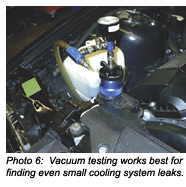 A quick check of several BMW owner’s manuals gave information that needs to be covered on vehicles where the owner claims there is “overheating,” when there are no signs that this is actually happening. A full system, operating thermostat, fan clutch, auxiliary fan and water pump will still allow the gauge to rise in slow traffic on hot days. The owner’s manual has stated for years that the “normal” operating range is anywhere between the blue and red areas on the gauge, and unless the warning light or check system indicates overheating, the system is operating correctly.
A quick check of several BMW owner’s manuals gave information that needs to be covered on vehicles where the owner claims there is “overheating,” when there are no signs that this is actually happening. A full system, operating thermostat, fan clutch, auxiliary fan and water pump will still allow the gauge to rise in slow traffic on hot days. The owner’s manual has stated for years that the “normal” operating range is anywhere between the blue and red areas on the gauge, and unless the warning light or check system indicates overheating, the system is operating correctly.
If there is coolant loss, an inoperative fan or a circulation problem, then more diagnosis is needed. Unless there are obvious signs of leakage, a pressure or vacuum test (See Photo 6) is needed to locate a leak. The most common leak points are the thermostat housing, water pump and radiator. Overtightening or replacing a hose clamp on an already weakened radiator neck sometimes causes cracked connections at the radiator. More often, the upper radiator connection will blow off, usually caused by another failure in the system.
Basic tests for the cooling system are like other cars. If there are no leaks, a warm-up period, either at idle, or during a short road test, and a check of the thermostat operation is the place to start. Turning the A/C on and off a few times will verify that the auxiliary fan is operational, but be aware that, depending on outside temperatures, the fan may not immediately come on on some models. BMW uses rather large radiators, so warm-up at idle can take awhile, but once the thermostat opens, verified with a temp gun, the radiator should heat fairly evenly from top to bottom. Some models have both engine-driven and electric fans, others just electric. Depending on the model, the fan circuit may include a temp switch in the radiator for the auxiliary fan, or just ECU control. Wiring diagrams are imperative to trace operation, being very particular about specific manufacturing date and components on a given car.
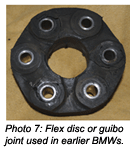 UNDERCAR
UNDERCAR
Newer BMW models have eliminated a trouble spot in the drivetrain. The use of the flexible disc, or guibo joint (See Photo 7), along with universal joints for the two-piece driveshaft, was probably OK until horsepower exceeded 200. Beyond that point, an upgrade was needed. Later models have replaced the flex disc and U-joints with CV joints.
The models with the flex discs develop vibration problems, often related to a driveshaft removal or improper rebuild. Alignment of the driveshaft in the body, and preloading of the center support bearing, must be performed any time the driveshaft is removed. The procedure is covered in the applicable service manual for the various models. Phasing of the U-joints on the early models is especially important, as it is with any vehicle with a two-piece shaft.
Suspension repairs on BMWs are pretty normal; although some special press tools are needed to properly and easily replace ball joints and bushings on some models. In many cases, the labor involved with removing and pressing bushings is more than offset by just replacing the control arm or bracket. When working with aluminum control arms, great care must be taken to avoid bending the arm to replace a ball joint or bushing.
ON THE INSIDE
A couple of common problems with the interior have become routine repairs for us. The climate control system on all BMWs is reliable to a point, and newer models seem to have solved some earlier failures, but only time will really prove the improvement. One problem involves control of the fan, and the other more common problem is an intermittent operation of the whole system.
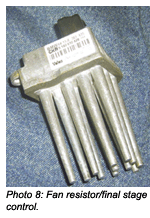 Often, the cars come in with a request to replace the heater fan, because it has stopped working, or works only on some speeds, but not all of them. After checking the fuses related to the climate control system (and there will be several), the most common failure will be the fan resistor (See Photo 8). Also known as the fan final stage control, it’s usually mounted to the lower front of the heater and A/C housing. Depending on the year and model, it’s removed from the passenger’s or driver’s side. The task is the same either way. You will need to remove the lower dash cover, contort your body, and find and remove the electrical connector at the resistor. With the electrical connector off, you can make your electrical tests to assure the diagnosis. You can also use a fused jumper to run the fan at this connector. The resistor is held into the heater housing with either one screw and a clip, or two screws. Either way, access is difficult, but with patience someone under two feet tall and 50 pounds can easily make the change; the rest of us will find it a challenge.
Often, the cars come in with a request to replace the heater fan, because it has stopped working, or works only on some speeds, but not all of them. After checking the fuses related to the climate control system (and there will be several), the most common failure will be the fan resistor (See Photo 8). Also known as the fan final stage control, it’s usually mounted to the lower front of the heater and A/C housing. Depending on the year and model, it’s removed from the passenger’s or driver’s side. The task is the same either way. You will need to remove the lower dash cover, contort your body, and find and remove the electrical connector at the resistor. With the electrical connector off, you can make your electrical tests to assure the diagnosis. You can also use a fused jumper to run the fan at this connector. The resistor is held into the heater housing with either one screw and a clip, or two screws. Either way, access is difficult, but with patience someone under two feet tall and 50 pounds can easily make the change; the rest of us will find it a challenge.
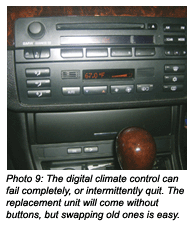 The other problem is common to all models with automatic climate control with a digital readout (See Photo 9). Though these units are fairly reliable, intermittent operation is common, and failure does occur. Rebuilt and new control heads are available, from both dealer and aftermarket sources. The replacement sequence is simple. Careful pulling with a couple of hooks or pry sticks will pop the unit out of the dash. Then you need to just remove the wiring harnesses. After removing the small screws from the rear of the faceplate, and releasing the clip at the bottom front, the faceplate will come off with the buttons attached. If the original faceplate and buttons are in good shape, I just transfer them to the new unit, or transfer the buttons to the new plate that usually comes with the unit. Reattach the wiring and reinsert the unit into the dash.
The other problem is common to all models with automatic climate control with a digital readout (See Photo 9). Though these units are fairly reliable, intermittent operation is common, and failure does occur. Rebuilt and new control heads are available, from both dealer and aftermarket sources. The replacement sequence is simple. Careful pulling with a couple of hooks or pry sticks will pop the unit out of the dash. Then you need to just remove the wiring harnesses. After removing the small screws from the rear of the faceplate, and releasing the clip at the bottom front, the faceplate will come off with the buttons attached. If the original faceplate and buttons are in good shape, I just transfer them to the new unit, or transfer the buttons to the new plate that usually comes with the unit. Reattach the wiring and reinsert the unit into the dash.
Unlike earlier BMW models, if the readout is in a different language, it takes more than just disconnecting the battery to change the readout. Units come either in U.S. or metric readout, and reprogramming is required to change the language. We just let our customers know before the replacement that this may happen, and usually it’s OK. We have not found an aftermarket scanner that will do this reprogramming for us.
FINISHING UP
From my own experience with BMWs, I’ve found them to be durable, reliable and well-made vehicles. The combination of quality, performance and surprising economy make them great people movers. As technicians, we often see only the worst of cars, the parts that break and the weird way things are put together. Compared to other brands in the same categories, BMW still comes out at the top of the list for many reasons. Learning to service them and then encouraging customers to look at these cars as long-term investments will do great things for your business.












